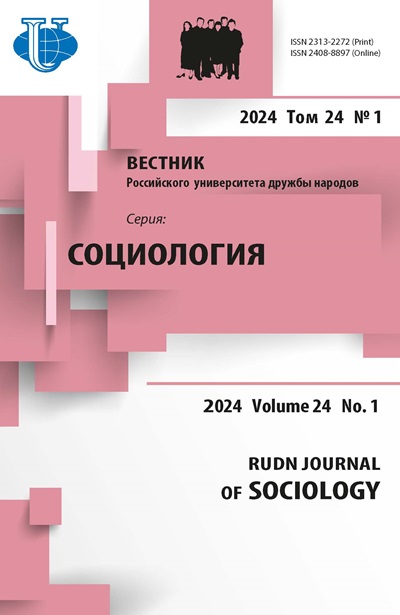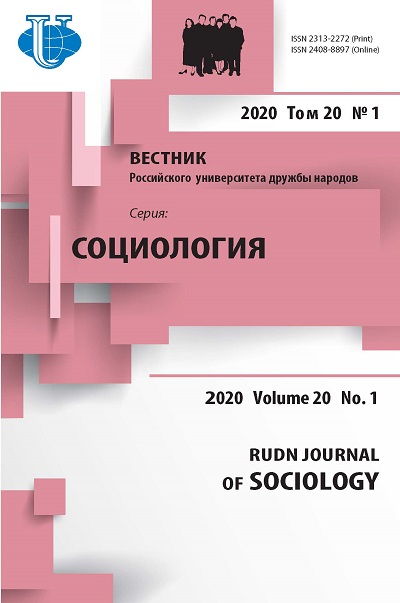The NEET youth: European context and Russian realities
- Authors: Bulanova M.B.1, Artamonova E.A.2
-
Affiliations:
- Russian State University for Humanities
- Moscow Institute of Physics and Technology
- Issue: Vol 20, No 1 (2020)
- Pages: 64-72
- Section: Contemporary society: the urgent issues and prospects for development
- URL: https://journals.rudn.ru/sociology/article/view/22944
- DOI: https://doi.org/10.22363/2313-2272-2020-20-1-64-72
Cite item
Full Text
Abstract
The article attempts to identify features and provide a social portrait of the NEET youth in the European and Russian contexts. The developed European countries faced the NEET phenomenon in the late 20th - early 21st century: according to the Eurostat definition, this group includes young people aged 15-24, unemployed or economically inactive, who do not study and do not get vocational training - in 2017, the NEET youth made on average 14.7% of the working population. In Russia, the number of NEETs is at the average European level - 15%. According to the classification of the International Labor Organization (ILO), there are two groups of NEETs: NEET-unemployed and NEET-inactive. The authors consider as the determining factor of becoming a part of the NEET group one’s unwillingness to work and study, i.e. the criteria of being NEET is not working (rather than being unemployed) and not studying (rather than being economically inactive). Thus, it is the forms of ‘social dependency’ of the NEET youth that make the study of this group so difficult. The article examines objective and subjective reasons for the emergence of this group and social consequences of being in the NEET group, whose representatives try to benefit from the situation. The authors show that the assessment of the NEET youth as marginal, i.e. a transitional and unstable group, encourages European states to provide assistance to these young people to help them to get out of the situation of non-working and non-studying. The article provides some examples of such assistance in Italy, Great Britain, Poland, Spain, and the Netherlands.
About the authors
M. B. Bulanova
Russian State University for Humanities
Author for correspondence.
Email: rsuh@rsuh.ru
доктор социологических наук, профессор кафедры теории и истории социологии
Miusskaya Pl., 6, Moscow, 125993, RussiaE. A. Artamonova
Moscow Institute of Physics and Technology
Email: info@mipt.ru
кандидат искусствоведения, старший преподаватель департамента иностранных языков
Institutsky Per., 9, Dolgoprudny, 141701, RussiaReferences
- Варшавская Е.Я. Российская NEET-молодежь: характеристики и типология // Социологические исследования. 2016. № 9 / Varshavskaya E.Ya. Rossiyskaya NEET-molodezh: kharakteristiki i tipologiya [Russian NEET-youth: Features and typology]. Sociologicheskie Issledovaniya. 2016; 9 (In Russ.).
- Вишневская Н., Зудина А. Экономически уязвимые группы молодежи в странах ОЭСР и России // Мировая экономика и международные отношения. 2018. Т. 62. № 11 / Vishnevskaya N.T., Zudina A.A. Ekonomicheski uyazvimye gruppy molodezhi v stranakh OESR i Rossii [Economically vulnerable youth in OECD and Russia]. Mirovaya Ekonomika i Mezhdunarodnye Otnosheniya. 2018; 62 (11) (In Russ.).
- Жизненный мир россиян: 25 лет спустя (конец 1980-х - середина 2000-х гг.) / Под ред. Ж.Т. Тощенко. М., 2016 / Zhiznenny mir rossiyan: 25 let spustya (konets 1980-h - seredina 2000-h gg.) [The Life World of Russians: 25 Years Later (late 1980s - mid 2000s)]. Pod. red. Zh.T. Toshchenko. Moscow; 2016 (In Russ.).
- Зудина А.А. «Не работают и не учатся»: NEET-молодежь на рынке труда в России. М., 2017 / Zudina A.A. “Ne rabotayut i ne uchatsya”: NEET-molodezh na rynke truda v Rossii [“They Do Not Work and Do Not Study”: NEET-Youth in the Russian Labor Market]. Moscow; 2017 (In Russ.).
- Зудина А.А. Дороги, ведущие в NEET: случай России // Экономический журнал. 2018. Т. 22. № 2 / Zudina A.A. Dorogi, vedushchiye v NEET: sluchay Rossii [Ways to NEET: The case of Russia]. Economichesky Zhurnal. 2018; 22 (2) (In Russ.).
- Курбатов В.И. NET-мышление: новые реалии информационной эры // Гуманитарий юга России. 2017. T. 6. № 6 / Kurbatov V.I. NET-myshlenie: novye realii informatsionnoy ery [NET thinking: New realities of the information era]. Gumanitary Yuga Rossii. 2017; 6 (6) (In Russ.).
- Лиходей О.А. Субъективные факторы маргинализации. М., 2001 / Likhodey O.A. Subiektivnye faktory marginalizatsii [Subjective Factors of Marginalization]. Moscow; 2001 (In Russ.).
- Тощенко Ж.Т. Прекариат. От протокласса к новому классу. М., 2018 / Toshchenko Zh.T. Prekariat. Ot protoklassa k novomu klassu [Precariat. From Protoclass to the New Class]. Moscow; 2018 (In Russ.).
- Alfieri S., Rosina, A., Sironi, E., Marta E., Manzana D. Who are Italian ‘Neets’? Trust in institutions, political engagement, willingness to be activated and attitudes toward the future in a group at risk for social exclusion. Rivista Internazionale di Scienze Sociali. 2015; 123 (3).
- Bridging the Gap: New Opportunities for 16-18 Year Olds Not in Education, Employment or Training. http://dera.ioe.ac.Uk/15119/2/bridging-the-gap.pdf.
- Eurostat: Young people neither in employment nor in education and training by sex, age and labor status. http://appsso.eurostat.ec.europa.eu/nui/show.do?dataset=edat_ lfse_20&lang=en
- Ermolieva E.G. Lost generation? The plight of young people in Europe. http://www.sov-europe.ru/ 2016/5-2016/9.pdf.
- Harnessing Automation for a Future That Works. https://www.mckinsey.com/featured-insights/ digital-disruption/harnessing-automation-for-a-future-that-works.
- Kariková S., Krystoň M., Michalovič V., Neupauer Z., Pavlov I., Vaněk B. Literacy of adults as a problem of inclusion and equality in lifelong learning. How to Work with NEETs. Recommendations for Policy and Practice. Kraków, 2018.
- NEETs: Young People Not in Employment, Education or Training: Characteristics, Costs and Policy Responses in Europe. Luxembourg; 2012.
- Ogawa А. Hikikomori in contemporary Japan. http://su.diva-portal.org/smash/get/diva2: 568035/FULLTEXT01.
- Rodríguez-Modroño P. Youth unemployment, NEETs and structural inequality in Spain. https://www.researchgate.net/publication/330434800_Youth_unemployment_NEETs_and_structural_inequality_in_Spain.
- Saczyńska-Sokół S. Supporting NEETs - challenges facing labor market institutions in Poland. https://www.researchgate.net/publication/324496870_Supporting_NEETs_-_challenges_facing_ labor_market_institutions_in_Poland.
- Serracant P. A brute indicator for a NEET case: Genesis and evolution of a problematic concept and results from an alternative indicator. Social Indicators Research. 2014; 117 (2).
- Spaaij R., Magee J., Jeanes R. Urban youth, worklessness and sport: A comparison of sports-based employability programmes in Rotterdam and Stoke-on-Trent. Urban Studies. 2013; 50 (8).
- Świętek A., Rachwał T., Kurek S., Osuch, W. Sytuacja młodzieży NEET w Polsce i propozycje podniesienia jej kompetencji przedsiębiorczych w świetle rezultatów projektu RLG // https://www.researchgate.net/publication/329873828_Sytuacja_mlodziezy_NEET_w_Polsce_ i_propozycje_podniesienia_jej_kompetencji_przedsiebiorczych_w_swietle_rezultatow_ projektu_RLG_Situation_of_NEETs_in_Poland_and_Proposals_for_developing_their_Entrepren.
- Williams A. Move Over, Millennials, Here Comes Generation Z. https://www.nytimes.com/ 2015/09/20/fashion/move-over-millennials-here-comes-generation-z.html.














